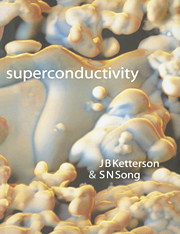Book contents
- Frontmatter
- Contents
- Preface
- Part I Phenomenologlcal theories of superconductivity
- 1 Introduction
- 2 The London–London equation
- 3 Pippard's equation
- 4 Thermodynamics of a Type I superconductor
- 5 The intermediate state
- 6 Surface energy between a normal and a superconducting metal
- 7 Quantized vorticity
- 8 Type II superconductivity
- 9 The Ginzburg–Landau theory
- 10 The upper critical field of a Type II superconductor
- 11 The anisotropic superconductor
- 12 Thin superconducting slabs
- 13 Surface superconductivity
- 14 The Type II superconductor for H just below Hc2
- 15 The Josephson effects
- 16 The Josephson lattice in ID
- 17 Vortex structure in layered superconductors
- 18 Granular superconductors: the Josephson lattice in 2D and 3D
- 19 Wave propagation in Josephson junctions, superlattices, and arrays
- 20 Flux pinning and flux motion
- 21 Time-dependent G–L theory
- 22 Fluctuation effects
- 23 G–L theory of an unconventional superfluid
- 24 Landau Fermi liquid theory
- Part II The microscopic theory of a uniform superconductor
- Part III Nonuniform superconductivity
- Appendix A Identical particles and spin: the occupation number representation
- Appendix B Some calculations involving the BCS wavefunction
- Appendix C The gap as a perturbation through third order
- Superconducting transition temperature, thermodynamic critical field, Debye temperature and specific heat coefficient for the elements
- References
- Additional reading
- List of mathematical and physical symbols
- Index
17 - Vortex structure in layered superconductors
Published online by Cambridge University Press: 05 June 2012
- Frontmatter
- Contents
- Preface
- Part I Phenomenologlcal theories of superconductivity
- 1 Introduction
- 2 The London–London equation
- 3 Pippard's equation
- 4 Thermodynamics of a Type I superconductor
- 5 The intermediate state
- 6 Surface energy between a normal and a superconducting metal
- 7 Quantized vorticity
- 8 Type II superconductivity
- 9 The Ginzburg–Landau theory
- 10 The upper critical field of a Type II superconductor
- 11 The anisotropic superconductor
- 12 Thin superconducting slabs
- 13 Surface superconductivity
- 14 The Type II superconductor for H just below Hc2
- 15 The Josephson effects
- 16 The Josephson lattice in ID
- 17 Vortex structure in layered superconductors
- 18 Granular superconductors: the Josephson lattice in 2D and 3D
- 19 Wave propagation in Josephson junctions, superlattices, and arrays
- 20 Flux pinning and flux motion
- 21 Time-dependent G–L theory
- 22 Fluctuation effects
- 23 G–L theory of an unconventional superfluid
- 24 Landau Fermi liquid theory
- Part II The microscopic theory of a uniform superconductor
- Part III Nonuniform superconductivity
- Appendix A Identical particles and spin: the occupation number representation
- Appendix B Some calculations involving the BCS wavefunction
- Appendix C The gap as a perturbation through third order
- Superconducting transition temperature, thermodynamic critical field, Debye temperature and specific heat coefficient for the elements
- References
- Additional reading
- List of mathematical and physical symbols
- Index
Summary
Dichalcogenides of transition metals such as NbSe2, superconductor/insulator superlattices, and high Tc oxide superconductors all have a layered structure. Most of these systems are Type II superconductors with relatively large K values. One of the fascinating characteristics of the layered superconductors is their strongly anisotropic magnetic properties. Usually, the coherence length perpendicular to the layer plane (ξ⊥ is much smaller than that parallel to the layer (ξ∥). The anisotropy can be characterized by an anisotropy ratio, γ, defined as γ = ξ∥ξ⊥. Other length scales of interest are the penetration length, λ, and the scale of intrinsic inhomogeneities.
Depending on the relative size of ξ⊥ and the layer spacing, s, we may identify three different regimes for the vortex structure in the layered, high-K superconductors: (1) If ξ⊥(T) > > s, then the layered structure is largely irrelevant and the superconductor may be regarded as threedimensional: anisotropic, but uniform. Since the coherence length diverges as Tc is approached, this regime will always occur sufficiently close to Tc. The vortex structure can be described using the London or G–L theories by introducing an anisotropic mass tensor as discussed in Sec. 11. (2) With decreasing temperature, we may have a regime where ξ⊥(T) < < s (especially in high Tc oxides). If both regimes can be entered by sweeping the temperature a 3D–2D crossover will occur at some temperature.
- Type
- Chapter
- Information
- Superconductivity , pp. 82 - 90Publisher: Cambridge University PressPrint publication year: 1999



